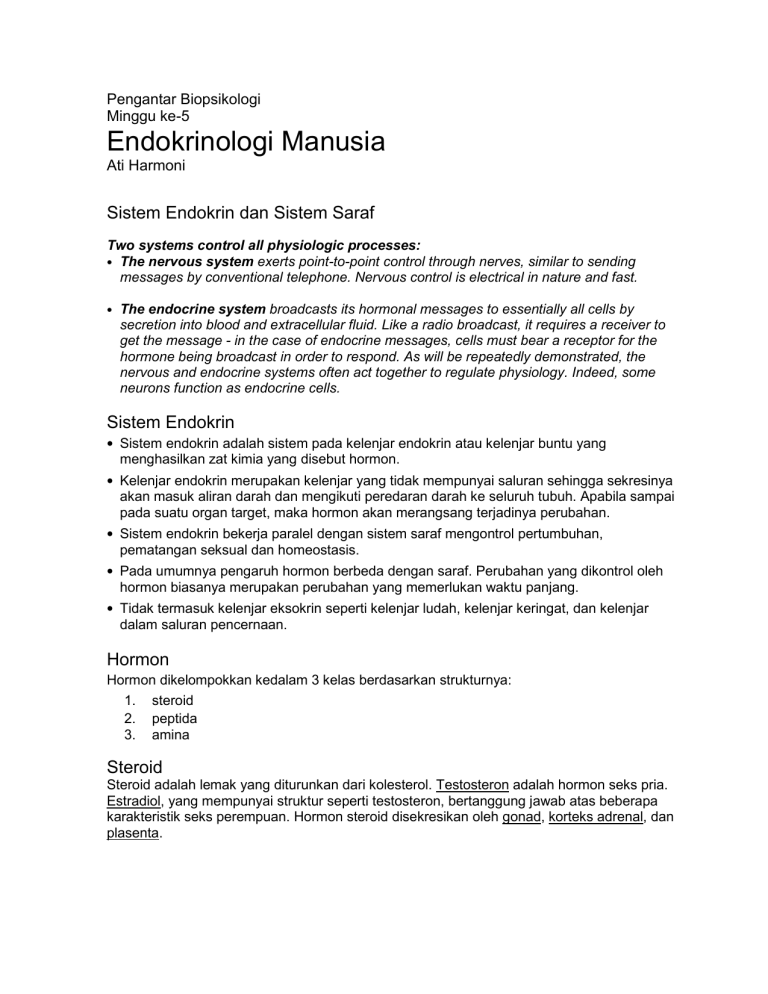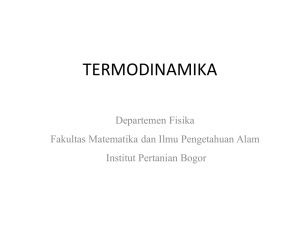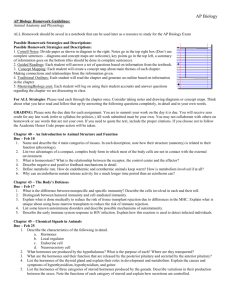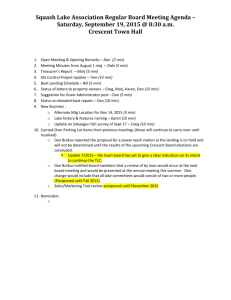endokrinologi manusia_1

Pengantar Biopsikologi
Minggu ke-5
Endokrinologi Manusia
Ati Harmoni
Sistem Endokrin dan Sistem Saraf
Two systems control all physiologic processes:
• The nervous system exerts point-to-point control through nerves, similar to sending
• messages by conventional telephone. Nervous control is electrical in nature and fast.
The endocrine system broadcasts its hormonal messages to essentially all cells by secretion into blood and extracellular fluid. Like a radio broadcast, it requires a receiver to get the message - in the case of endocrine messages, cells must bear a receptor for the hormone being broadcast in order to respond. As will be repeatedly demonstrated, the nervous and endocrine systems often act together to regulate physiology. Indeed, some neurons function as endocrine cells.
Sistem Endokrin
•
Sistem endokrin adalah sistem pada kelenjar endokrin atau kelenjar buntu yang menghasilkan zat kimia yang disebut hormon.
•
Kelenjar endokrin merupakan kelenjar yang tidak mempunyai saluran sehingga sekresinya akan masuk aliran darah dan mengikuti peredaran darah ke seluruh tubuh. Apabila sampai pada suatu organ target, maka hormon akan merangsang terjadinya perubahan.
•
Sistem endokrin bekerja paralel dengan sistem saraf mengontrol pertumbuhan, pematangan seksual dan homeostasis.
•
Pada umumnya pengaruh hormon berbeda dengan saraf. Perubahan yang dikontrol oleh hormon biasanya merupakan perubahan yang memerlukan waktu panjang.
•
Tidak termasuk kelenjar eksokrin seperti kelenjar ludah, kelenjar keringat, dan kelenjar dalam saluran pencernaan.
Hormon
Hormon dikelompokkan kedalam 3 kelas berdasarkan strukturnya:
1. steroid
2. peptida
3. amina
Steroid
Steroid adalah lemak yang diturunkan dari kolesterol. Testosteron adalah hormon seks pria.
Estradiol, yang mempunyai struktur seperti testosteron, bertanggung jawab atas beberapa karakteristik seks perempuan. Hormon steroid disekresikan oleh gonad, korteks adrenal, dan plasenta.
Peptida and Amina
1
Peptida adalah rantai asam amino pendek; kebanyakan hormon adalah peptida. Hormon tersebut disekresikan oleh pituitari, paratiroid, jantung, lambung, hati, dan ginjal.
Amina diturunkan dari asam amino tirosin dan disekresikan oleh tiroid dan medula adrenalin.
2
Gb. 1 dan 2
Tujuh kelenjar endokrin yang penting, yang membentuk sistem endokrin manusia, yaitu hipofisis (pituitary gland), tiroid, paratiroid, kelenjar adrenalin (anak ginjal), pankreas, ovarium, dan testis
Gb. 3
Kerja hormon dalam memilih sel target dan mengantarkan pesan hormonal
Synthesis, Storage, and Secretion
• Steroid hormones are derived from cholesterol by a biochemical reaction series. Defects along this series often lead to hormonal imbalances with serious consequences. Once synthesized, steroid hormones pass into the bloodstream; they are not stored by cells, and the rate of synthesis controls them.
• Peptide hormones are synthesized as precursor molecules and processed by the endoplasmic reticulum and Golgi where they are stored in secretory granules. When needed, the granules are dumped into the bloodstream. Different hormones can often be made from the same precursor molecule by cleaving it with a different enzyme.
• Amine hormones (notably epinephrine) are stored as granules in the cytoplasm until needed.
Sistem Endokrin dan Siklus Umpan Balik
•
Sistem endokrin menggunakan siklus dan umpan balik negatif (cycles and negative feedback) untuk mengatur fungsi fisiologis.
•
Umpan balik negatif mengatur sekresi hampir setiap hormon.
•
Siklus sekresi menjaga kontrol fisiologis dan homeostatis. Durasi siklus ini bervariasi antara jam sampai bulanan.
Gb.4
Negative feedback in the thyroxine release reflex
Mechanisms of Hormone Action
•
The endocrine system acts by releasing hormones that in turn trigger actions in specific target cells.
•
Receptors on target cell membranes bind only to one type of hormone. More than fifty human hormones have been identified; all act by binding to receptor molecules.
•
The binding hormone changes the shape of the receptor causing the response to the hormone. There are two mechanisms of hormone action on all target cells.
Nonsteroid Hormones
•
Nonsteroid hormones (water soluble) do not enter the cell but bind to plasma membrane receptors, generating a chemical signal (second messenger) inside the target cell. Five different second messenger chemicals, including cyclic AMP have been identified. Second messengers activate other intracellular chemicals to produce the target cell response.
Gb.5
The action of nonsteroid hormones
Steroid Hormones
•
The second mechanism involves steroid hormones, which pass through the plasma membrane and act in a two step process. Steroid hormones bind, once inside the cell, to the nuclear membrane receptors, producing an activated hormone-receptor complex. The activated hormone-receptor complex binds to DNA and activates specific genes, increasing production of proteins.
Gb.6
The action of steroid hormones








